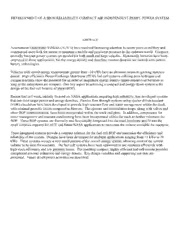
NASA Technical Reports Server (NTRS) 20130013734: Development of a High Reliability Compact Air Independent PEMFC Power System PDF
Preview NASA Technical Reports Server (NTRS) 20130013734: Development of a High Reliability Compact Air Independent PEMFC Power System
DEVELOPMENT OF A HIGH RELIABILITY COMPACT AIR INDEPENDENT PEMFC POWER SYSTEM ABSTRACT Autonomous Underwater Vehicles (AUV’s) have received increasing attention in recent years as military and commercial users look for means to maintain a mobile and persistent presence in the undersea world. Compact, neutrally buoyant power systems are needed for both small and large vehicles. Historically batteries have been employed in these applications, but the energy density and therefore mission duration are limited with current battery technologies. Vehicles with stored energy requirements greater than ~10 kWh have an alternate means to get long duration power. High efficiency Proton Exchange Membrane (PEM) fuel cell systems utilizing pure hydrogen and oxygen reactants show the potential for an order of magnitude energy density improvement over batteries as long as the subsystems are compact. One key aspect to achieving a compact and energy dense system is the design of the fuel cell balance of plant (BOP). Recent fuel cell work, initially focused on NASA applications requiring high reliability, has developed systems that can meet target power and energy densities. Passive flow through systems using ejector driven reactant (EDR) circulation have been developed to provide high reactant flow and water management within the stack, with minimal parasitic losses compared to blowers. The ejectors and recirculation loops, along with valves and other BOP instrumentation, have been incorporated within the stack end plate. In addition, components for water management and reactant conditioning have been incorporated within the stack to further minimize the BOP. These BOP systems are thermally and functionally integrated into the stack hardware and fit into the small volumes required for AUV and future NASA applications to maximize the volume available for reactants. These integrated systems provide a compact solution for the fuel cell BOP and maximize the efficiency and reliability of the system. Designs have been developed for multiple applications ranging from <1 kWe to 70 kWe. These systems occupy a very small portion of the overall energy system, allowing most of the system volume to be used for reactants. The fuel cell systems have been optimized to use reactants efficiently with high stack efficiency and low parasitic losses. The resulting compact, highly efficient fuel cell system provides exceptional reactant utilization and energy density. Key design variables and supporting test data are presented. Future development activities are described.
